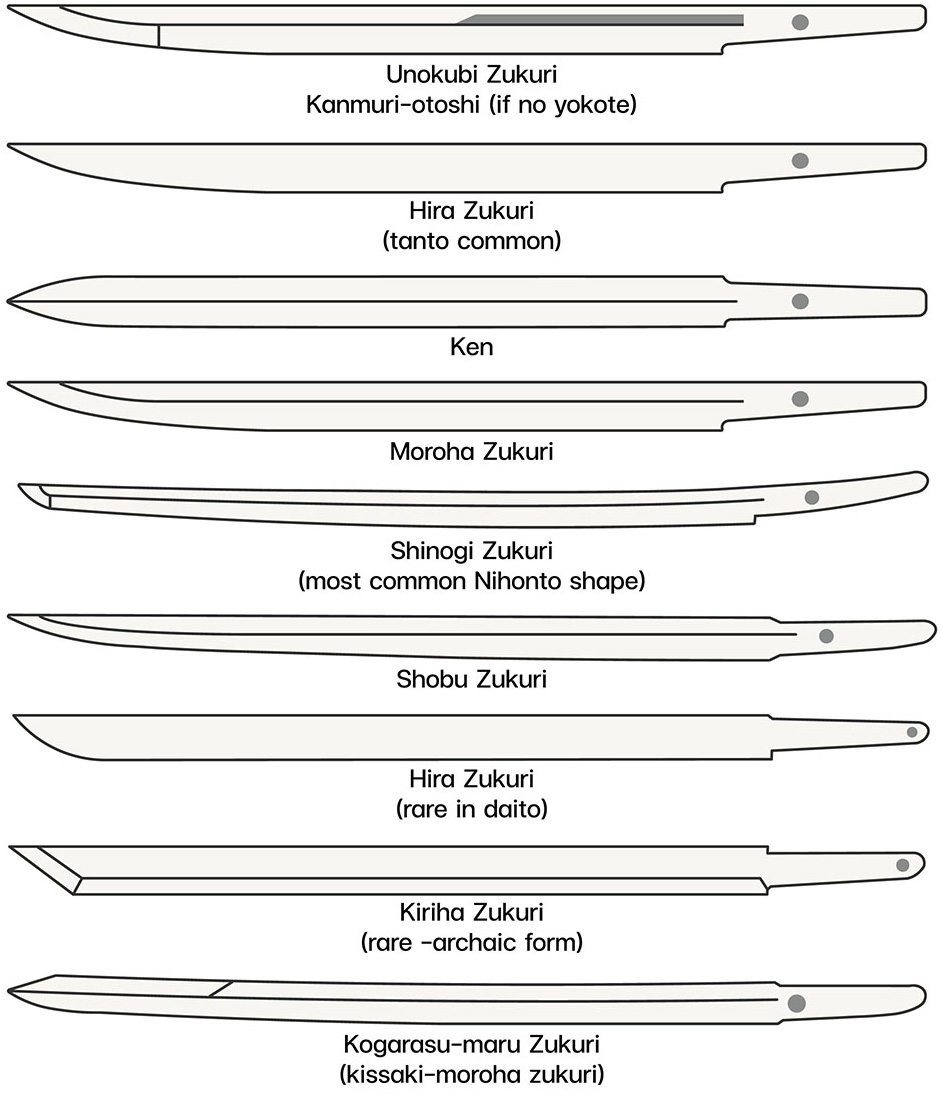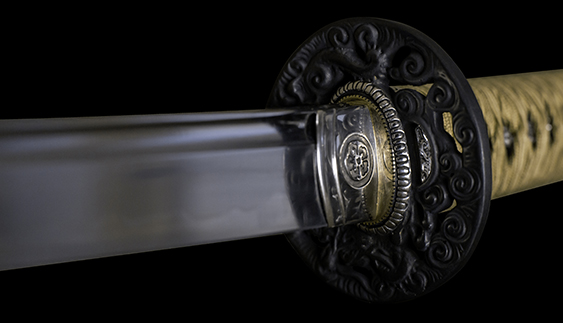Japanese Sword Components
The components of the Japanese sword from the picture are numbered to represent each part as shown in the following sections.
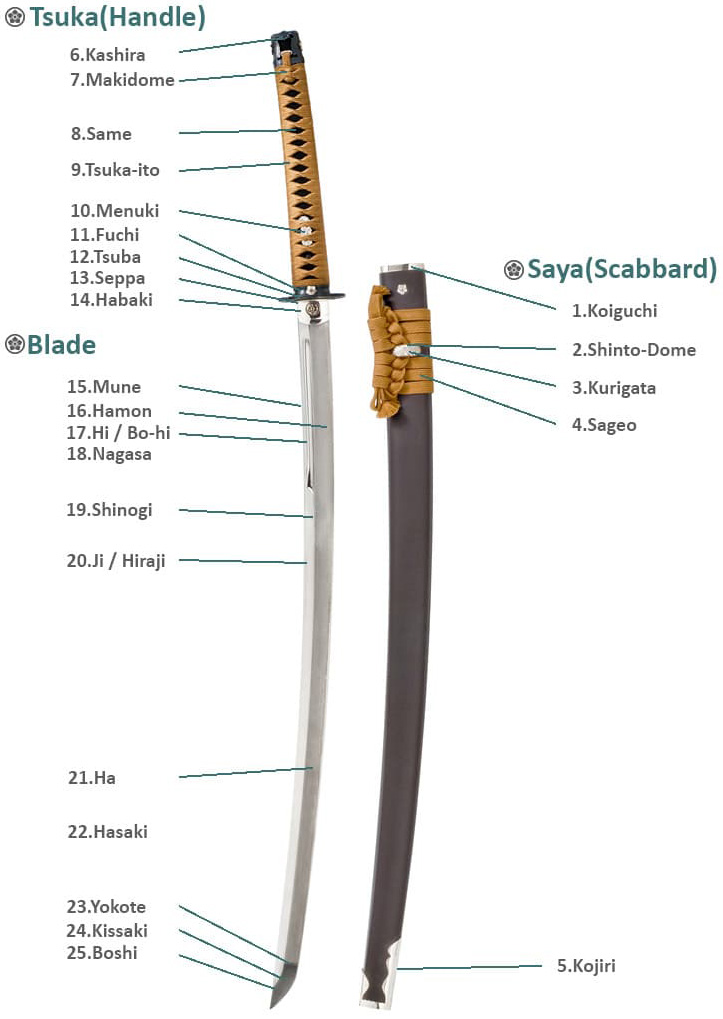
1. Saya(Scabbard) has 5 parts
1-1. Koiguchi
The koiguchi is part of the saya and is the part that touches the habaki, and this part must be tight enough to hold the scabbard out.
1-2. Shinto-Dome (inside Kurikata)
It is a decorative part that is usually worn with a kurigata. It looks like a small ring. This part will have sageo as a coiled string through it.
1-3. Kurigata
It is the part that is used to wrap with Sageo for beauty. In line with OBI's use Martial Arts Practice Sword. The Kurigata is positioned approximately one third of Saya's position.
1-4. Sageo
Sageo is traditionally a rope made of silk or cotton. There are many different types of wrapping on the Saya that give different aesthetics. Sageo is used as a cord that is worn between Obi and Kurigata during training.
1-5. Kojiri
Kojiri is the last end of the Scabbard. Covered to protect Saya from hitting the floor. It also gives beauty. The materials used to make Kojiri may be metal such as silver, copper or gold and buffalo horn.
2. Tsuka(Handle) has 9 parts
2-1. Kashira
It looks like a cap at the end of the tsuka where ito will tie into a knot . May be beautifully decorated with patterns that tell the story of the sword and help protect the handle more strong
2-2. Makidome
It is the end of the tsuka ito, tightly knotted to ensure it does not come loose.
2-3. Same
It is part of the stingray skin to increase the friction in the adhesion of ito, resulting in the firmness of the tsuka. Same's surface must be blistered and rough.
2-4. Tsuka-ito
It is the part of the rope that is used to wrap around the tsuka that holding the handle of the sword user is comfortable and does not hurt the hand .The material that can be silk, cotton or animal skin. There are many styles of ito wrap and they have different aesthetics. the best using what is called Hishigami squares to create perfectly shaped diamond patterns (which is, as you might expect, time consuming and expensive to do on a production sword).
2-5. Menuki
is the part that makes the sword user grab tsuka is more stable and more comfortable menuki will increase the size of the tsuka to make it easier to hold It also provides beauty with various patterns that are put into it. which Japanese people are detailed . The menuki position can be switched depending on whether one is left-handed or right-handed.
2-6. Fuchi
the top cover, the top tsuka is a target that pairs with kashira. Don't forget to come along in between. Fushi-Kashira As below for tsuba there is a definite mistake which of course also keep in mind.
2-7. Tsuba
is the beauty and the most noticeable part of the Japanese sword. The reason for its use is to prevent the user's hand from slipping to the blade edge .The material used to make tsuba is steel, copper or brass.
2-8. Seppa
Is the part that is used to separate the habaki and tsuba. It has an oval shape. To accommodate the impact between habaki and tsuba, the material used is copper, silver or brass.
2-9. Habaki
It is the part that looks like a blade collar that absorbs all the forces while using the katana, so it must have properties that are strong enough to withstand those impacts without tearing. It is also a part that helps The sword does not let it flow out of the scabbard easily because there may be a danger of an event that user grabs the blade and cuts the hand. The material used to make habaki is silver, copper or brass.
3. Blade has 10 parts
3-1. Mune
is the back of blades.Mostly of them looks like a gable roof, but there are some types of mune which flat .
3-2. Hamon
The most attractive part of a Japanese sword is the separation between the hard edge and the soft body of blade. It has a beautiful wavy appearance. There are many types of waves, such as hamon, which can occur in the hardening process where the mixture between mud and carbon are applied on the blade during quenching. Resulting in an unequal cooling rate , creating a different hardness area, making the edge harder than the blade body. which will have the ability to maintain a good edge(hard area) and at the same time have high flexibility(soft area) in the same blade.
There are many types of temper line,
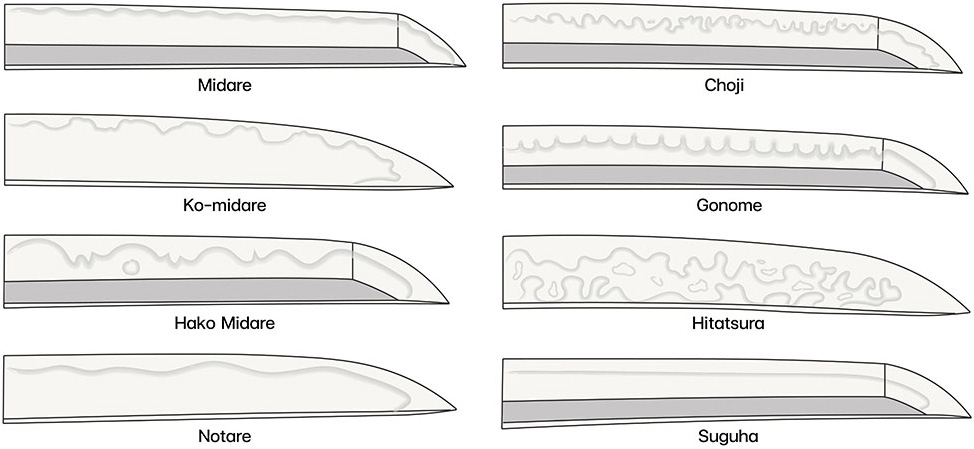
3-3. Hi / Bo-hi
It is the part that makes the blade more beautiful and interesting But its main function is to reduce the weight of the blade and swordsmiths often use this technique to restore balance to the blade. While using the sword, a whoosh whoosh sound of wind is heard, that is, the phenomenon of wind passing through Hi/Bo-hi. Hi/Bo-hi comes in many forms:
-Standard full length groove that terminates either just before or actually under the habaki blade collar, there are several less common variants.
-Double Bo-hi which has two - shallower - fullers instead of one. However, from a practical viewpoint, the effect on handling is the same as a single, deeper fuller - the only difference is, it is perhaps more visually interesting
-Partial bohi, that is to say, a groove around 1/3 the length of the actual blade.
3-4. Nagasa
Is the length of the blade starting from the back of the habaki (Munemachi) to the tip of the blade, which is called shaku. For example, 2.5 shaku= 74.93 cms.
3-5. Shinogi
is the ridge line on middle part of the blade.
20.Ji / Hiraji
t is the upper part of the blade itls the area between the shinogi and Mune.
3-6. Ha
It is the sharp edge of the blade at the point where the two planes of ji intersect. This point is considered to be where high hardness is required for the blade to maintain its edge well. The hardness should be in the range of 50-65 HRC, if lower than 45 HRC, it will become blunt easily(too soft) It's actually a rolled edge Phenomenon.
3-7. Hasaki
is the edge of the blade .It's the opposite of the Mune. if viewed from the side of the blade.
3-8. Yokote
linear Between the kissaki and ha is the line indicating the end of the kissaki area. Yokote common appears in Shinogi Zukuri' and is not present in some blades such as Shobu Zukuri.
3-9.Kissaki
is the part of the tip of the blade with a yokote line indicating the end of the kissaki. A particularly short one is called a Kokissaki and was commonly seen on 12th century Tachi swords, the precursor to the Katana. A standard length tip is called a Chukissaki, and a long one, an Okissaki.
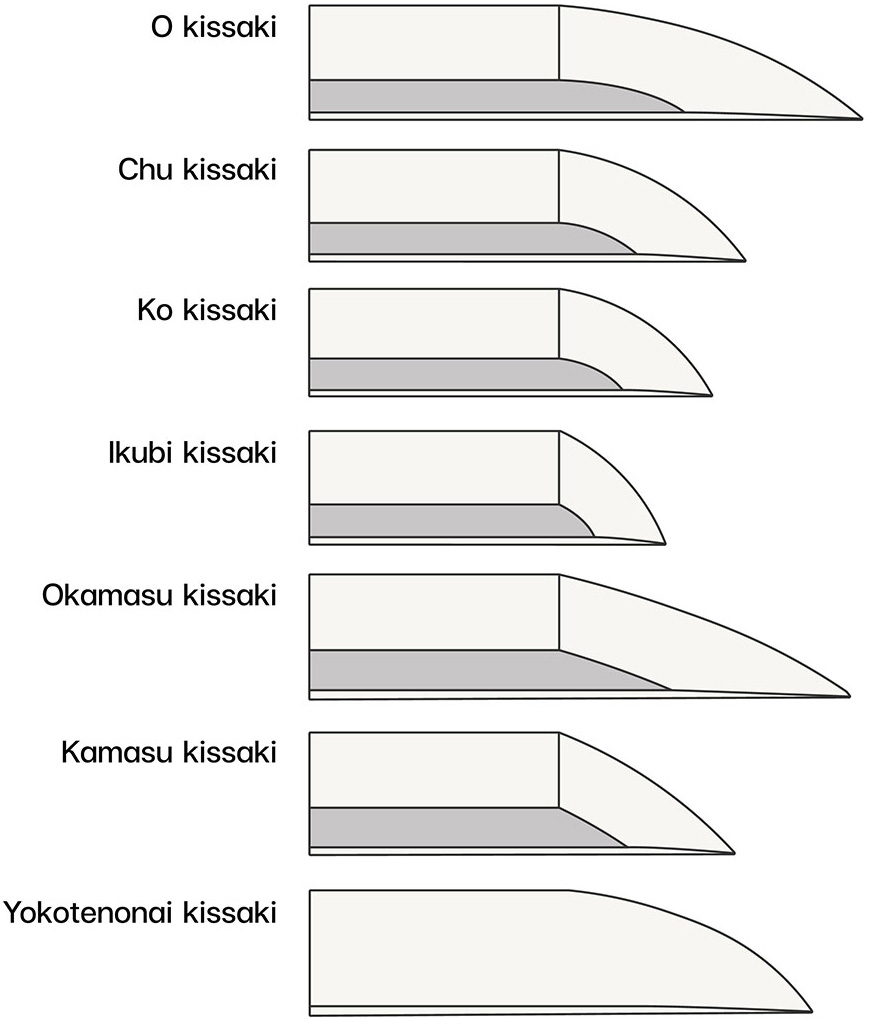
3-10.Boshi
It is the part of the hamon that is at the tip of the sword or the hamon that is in the kissaki area.
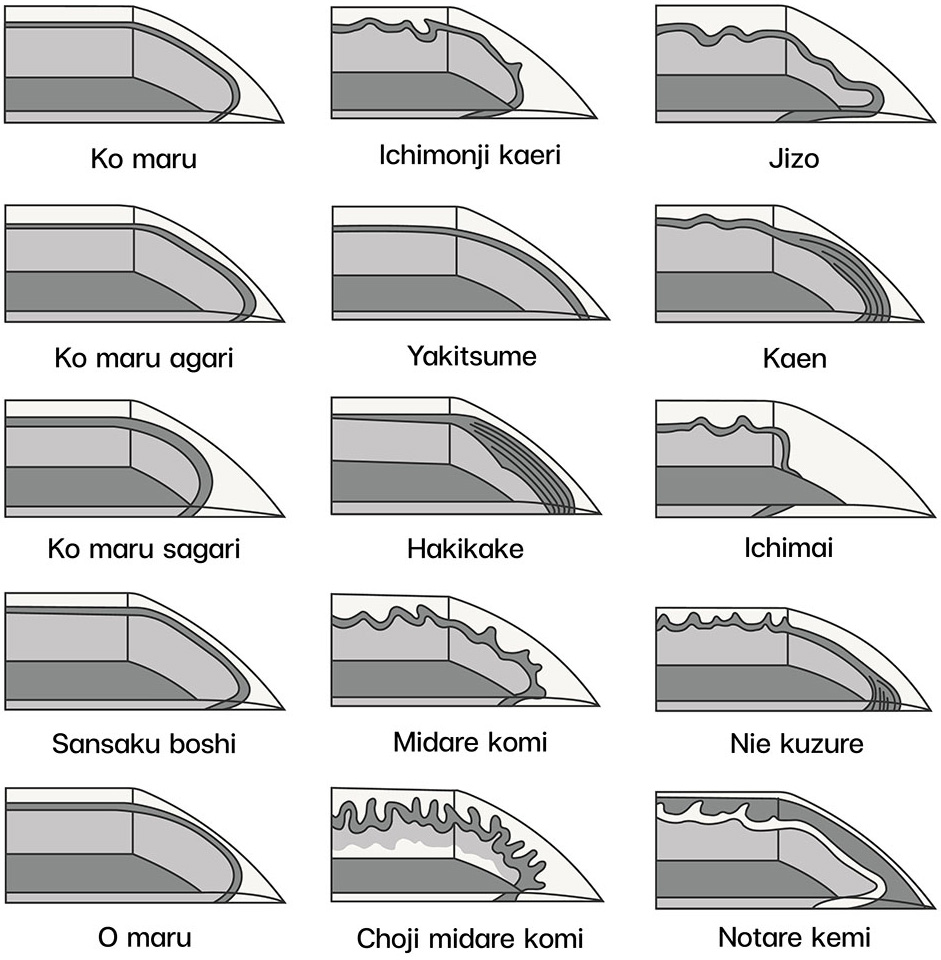
The structure of the blade of the KATANA or Japanese Sword.
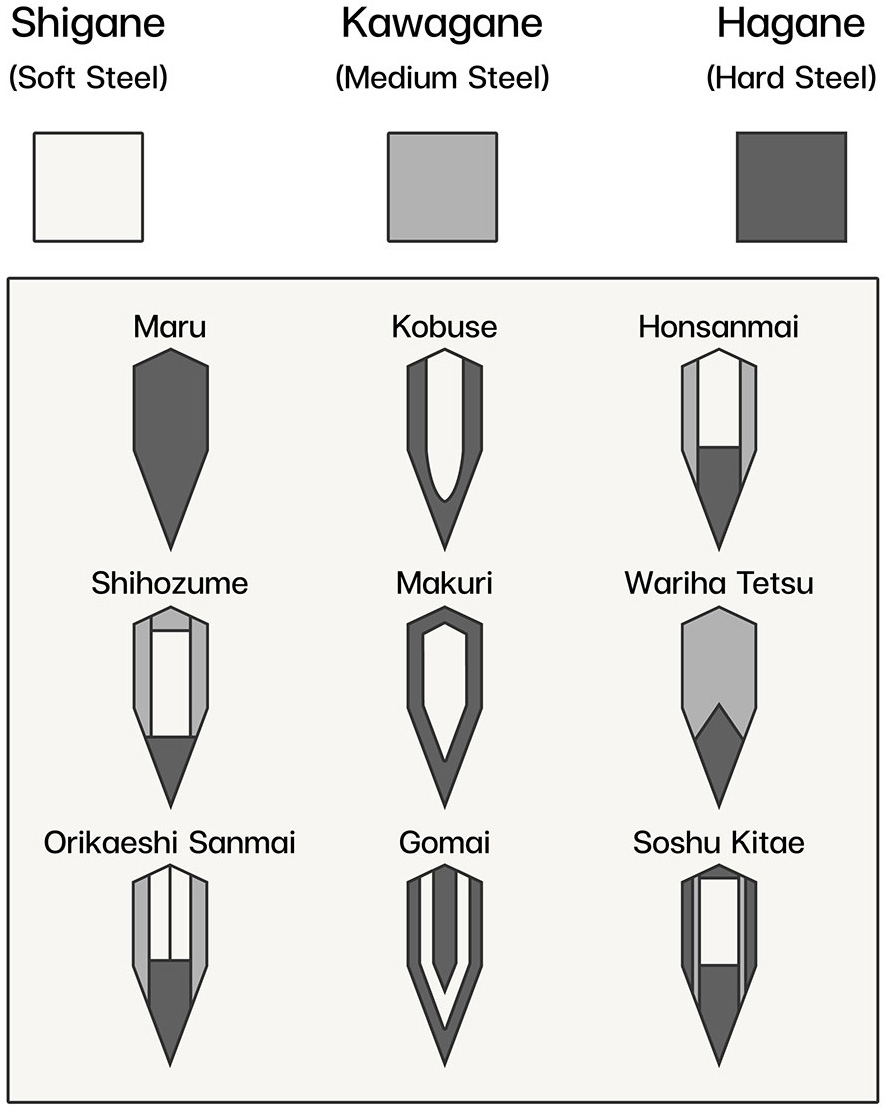
There are many styles of blades, each with a different center of balance.
